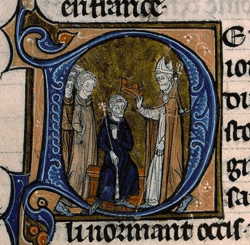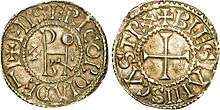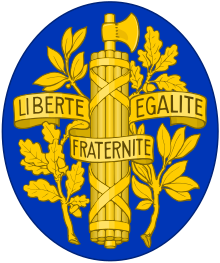Odo of France
Odo (or Eudes) (c. 857 – 1 January 898) was the elected King of the West Franks from 888 to 898 as the first king from the Robertian dynasty. Before assuming the kingship, Odo held the title of Count of Paris.[2] He is the first West Francian monarch to reign over a definitively separate kingdom that was part of the Carolingian Empire, never to be reunited again completely.
| Odo | |
|---|---|
| King of West Francia (originally Count of Paris) | |
 The Coronation of Odo, from the Grandes Chroniques de France | |
| Reign | 888–898 |
| Coronation | February 888, Compiègne |
| Predecessor | Charles the Fat |
| Successor | Charles the Simple |
| Born | c. 857 [1] |
| Died | 1 January 898 La Fère, West Francia |
| Spouse | Théodrate of Troyes |
| House | Robertian |
| Father | Robert the Strong |
| Mother | Adelaide of Tours |
Biography
.jpeg)

Odo was the eldest son of Robert the Strong, who was Duke of the Franks, Marquis of Neustria, and Count of Anjou. After his father's death at the Battle of Brissarthe in 866, Odo inherited his Marquis of Neustria title. Odo lost this title in 868 when king Charles the Bald appointed Hugh the Abbot to the title. Odo regained it following the death of Hugh in 886. After 882 he held the post of Count of Paris. Odo was also the lay abbot of St. Martin of Tours.[3][4]
In 882 or 883 Odo married Théodrate of Troyes.[5] Evidence of their children comes from non-contemporary or historically inauthentic sources. The eleventh-century chronicler Adémar de Chabannes wrote that they had a son, Arnoul (c.882-898), who died shortly after his father. Guy is named as one of the couple's children in an Alan I's charter dated 28 August 903, but genealogist Christian Settipani says it's a falsification.[6] The genealogical work Europäische Stammtafeln refers to Raoul as a son of Odo by Théodrate, but its primary source is not known.
For his skill and bravery in resisting the attacks of Vikings at the Siege of Paris (885-886), Odo was chosen by the western Frankish nobles to be their king following the overthrow of Emperor Charles the Fat. He was crowned at Compiègne in February 888 by Walter, Archbishop of Sens.[7]
Odo continued to battle against the Vikings and defeated them at Montfaucon, but was soon involved in a struggle with powerful Frankish nobles who supported the claim of Charles the Simple to the throne.[8]
In 890 Odo granted special privileges to the County of Manresa in Osona.[9] Because of its position on the front line against the Moorish aggression, Manresa was given the right to build towers of defence known as manresanas or manresanes. This privilege was responsible for giving Manresa its unique character, distinct from the rest of Osona, for the next two centuries.
To gain prestige and support, Odo paid homage to the East Francia's King Arnulf in 888.[10] [11] Despite this, in 894 Arnulf declared his support for Charles the Simple, and after a conflict which lasted three years, Odo was compelled to come to terms with his rival and surrender a district north of the Seine to him.[12] Odo died in La Fère on 1 January 898.[13]
In popular culture
A character named Count Odo is portrayed by Owen Roe[14] in the History Channel's 2013 hit TV series Vikings. This fictional Odo actually saves Paris from a Viking attack, but is killed before ever succeeding in becoming king.[15]
References
- Medieval France: An encyclopedia: "Odo (ca.857-898), King of the West Franks (r.888-898) "
- Jim Bradbury. The Capetians: Kings of France 987-1328. Bloomsbury Publishing, 2007. p 28-32
- Ernest Lavisse, Histoire de France, tome ii. (Paris, 1903)
- E. Favre, Eudes, comte de Paris et roi de France (Paris, 1893)
- Carl Johan Lamm. Oriental Glass of Mediaeval Date Found in Sweden and the Early History of Lustre-painting. Akad. Förl., 1941. p 41
- Christian Settipani. La Préhistoire des Capétiens (Nouvelle histoire généalogique de l'auguste maison de France). P. Van Kerrebrouck, 1993. p 402-403
- Gwatking, H. M., Whitney, J. P., et al. Cambridge Medieval History: Volume III—Germany and the Western Empire. Cambridge University Press:London(1930)
- Jim Bradbury. The Capetians: Kings of France 987-1328. Bloomsbury Publishing, 2007. p 31-32
- Michel Zimmermann. Western Francia: the southern principalities. In: The New Cambridge Medieval History: Volume 3, C.900-c.1024. Edited by Rosamond McKitterick, David Abulafia, Michael C. E. Jones. p 433
- Anthony Guggenberger. A General History of the Christian Era: The papacy and the empire. B. Herder, 1909. p 162
- Paul Edward Dutton. The Politics of Dreaming in the Carolingian Empire. University of Nebraska Press, 1994. p 229
- "Odo". Encyclopedia Britannica. 20: 4. 1911. Retrieved 26 January 2019.
- Jim Bradbury. The Capetians: Kings of France 987-1328. Bloomsbury Publishing, 2007. p 32
- https://www.theagency.ie/owen-roe
- https://www.ancient.eu/article/1285/vikings-tv-series---truths-and-fictions/
Bibliography
![]()
External links

| Regnal titles | ||
|---|---|---|
| Preceded by Charles the Fat |
King of West Francia 888–898 |
Succeeded by Charles the Simple |
| Titles of nobility | ||
| Preceded by Conrad |
Count of Paris 882–888 |
Succeeded by Robert |
| Preceded by Hugh the Abbot |
Margrave of Neustria 886–888 | |
